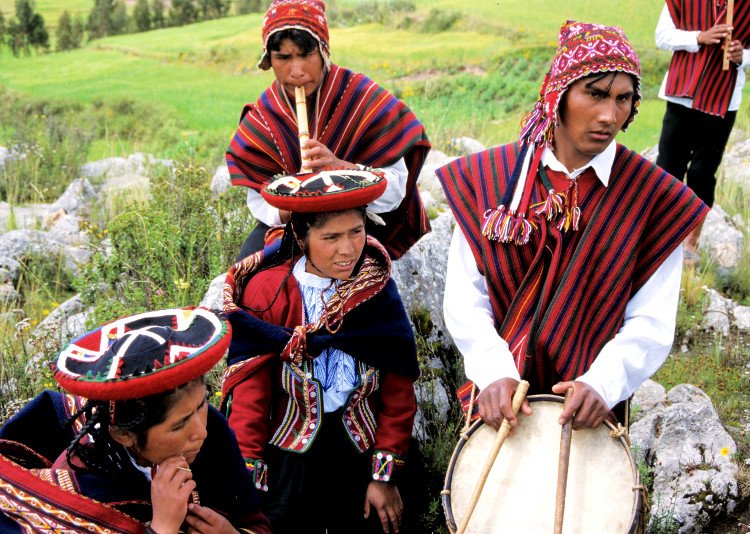MINK'A
Songs of the earth and youth
Chinchero is a quiet town of 3000 inhabitants situated thirty-odd kilometres to the north of Cuzco. The main human activity is agriculture. The high altitude, the poverty of the soil and the harshness of the climate make it difficult to grow crops other than potatoes, quinoa – an Andean cereal – a few very hardy local tubers such as lisas and maswa and sometimes, corn. All social organisation of the Quechua Indians who people this part of the Andes cordillera is conditioned by the strong relationship between these farmers and the land.
During the agrarian reform (1968 –1975), the lands of large owners were shared out among the population and the “communities”. This parcelling out was a success, but the divided and individualised working of the land that it led to has proved to be a failure, paradoxically leading to a loss of independence for the aforementioned communities. The dismantling of the social organisations, and privatisation in the eighties, as well as the neo-liberal ultra-individualism and the interventionism of North American evangelical sects, contributed to the destructuring of the community spirit and work ethic in general.
Today, the population of Chinchero is divided into 13 “communities”. According to a complex relational system, these communities manage all the village land which is community owned. In this way, they are reviving an ancestral usage of collective land occupation and use which dates back to before Spanish colonisation. The communities provide each family with a small plot of land (topo), approximately a tenth of a hectare, for their personal use. Although this system of collective farming of the land is widely spread throughout the Cuzco region, it is struggling to survive in the face of the strong population increase which, through the multiplication of topos, provokes an inevitable parcelling of the collective lands, a systematic impoverishing of the communities and eventually, an inescapable rural exodus.
The origin of community work and its structuring date back to the times of the Inca empire. The Inca conception of the State comprised a rigorously codified and co-ordinated set of collective duties and tasks, such as, for example, the obligation of the communities to carry out certain works for the central State (ayni). Today the Quechua still perpetuate some of these collective practises, such as reciprocal help between families (mink’a) – during, for example, the construction of a house – and the carrying out of collective works for the community (faena) such as field work, the upkeep of paths, the construction of municipal buildings,… In these isolated and underprivileged regions, these expressions of rural solidarity are holding their own against the pipe dream of city individualism, too often equated with progress.
On the other hand, the revival of indigenous expression throughout the Andean communities as a whole also encourages the reinstatement of certain traditions. Thus, traditional music is being reintroduced throughout the Andes by very young musicians 1 whose motivation is often more “political” and identity-oriented in nature than strictly traditional.
For the Quechua, music was firstly a means of opening communication between the spiritual and inner worlds, particularly on fixed dates, during sowing and harvesting. Each agrarian cycle had its corresponding instrumentation and special repertoire. The conversion of the Pre-Colombian rites to Christianity had led to a sort of moral and religious consensus to which, under duress, the Quechua had submitted. Today, many Quechua are returning to their roots. Some are opting for political and trade union action, others are restoring their cultural patrimony or attempting to save what is left of it. The Takiy huayna group’s initiative is an illustration of this resistance.
Rising awareness among the youth
The Takiy huayna (El Cantar de los Jovenes) is a group of about ten musicians, boys and girls, aged under thirty. It was formed at the end of the nineties with the express purpose of safeguarding the musical traditions of the region of Chinchero. Being the only band in Chinchero and the surrounding area, its members play in public or accompany traditional dances at all the religious or family celebrations of the various communities.Their instrumental and vocal repertoire (in the Quechua language), was collected from the elders and carefully written down to preserve its memory. Similarly, the traditional instruments have been reinstated, though these days, some musicians openly express their desire for more modern, electronic instruments. The most frequently used instruments are the little notched flute (quena), the conch (pututo), the drum (tinya) and the big drum with the double membrane (bombo). The big flutes (lawato), are hardly used anymore in the region, even by a group sensitised to the traditions as is Takiy huayna of Chinchero.
These recordings were made in April 2002, on the square in front of the little church Huancapata de Pumagaga, an ancient ‘christianised’ Inca site overhanging Chinchero (3800 metres).
- In the same collection, the record Wayra – Music of the Yampara and Charka Indians (Col. CD 109) illustrates a similar initiative of cultural resistance, by a group of young half-castes (Comunidad Pachamama) of the Sucre region, in Chuquisaca in Bolivia.
|
CD tracks
|

